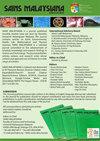绘制和预测北苏门答腊贫困状况的机器学习:数据驱动方法
IF 0.7
4区 综合性期刊
Q3 MULTIDISCIPLINARY SCIENCES
引用次数: 0
摘要
讨论贫困问题至关重要,因为它影响到社会的许多方面,包括社会经济差距、犯罪和无法获得优质教育。北苏门答腊省是印尼贫困率最高的省份之一。需要制定一项战略来收集准确的数据,以有效减少贫困。在北苏门答腊省进行了贫困绘图和预测,以获得精确的贫困空间分布、贫困模型的运行以及使用机器学习(ML)进行预测。贫困预测采用随机森林(RF)算法,贫困绘图采用 K-Means 算法。贫困图谱显示,在肘图的第三和第四簇中,惯性值明显下降。在剪影指数上,第三簇(0.313)优于第四簇(0.244)。因此,模型中使用了低、中、高三个贫困群组。最佳模型是通过网格搜索交叉验证创建的,而最佳预测结果则是通过 RF 算法创建的,其参数如下:n-估计器 = 50,最大深度 = 10,最小样本分割 = 2,最小样本叶 = 1。射频模型预测的均方误差(MSE)为 0.002617,精度令人满意。本文章由计算机程序翻译,如有差异,请以英文原文为准。
Machine Learning for Mapping and Forecasting Poverty in North Sumatera: A Data-Driven Approach
Discussing poverty is crucial because it affects many facets of society, including socioeconomic disparity, crime, and the inability to obtain high-quality education. One of the provinces with the highest poverty rate in Indonesia is North Sumatra. A strategy is required to gather accurate data to effectively reduce poverty. Poverty mapping and prediction were conducted in North Sumatra to get a precise spatial distribution of poverty, the operation of the poverty model, and forecasting using machine learning (ML). Poverty prediction was conducted using a random forest (RF) algorithm and poverty mapping was conducted using the K-Means algorithm. The poverty mapping showed a significant inertia value decline in the third and fourth clusters of the elbow graph. The third cluster (0.313) was superior to the fourth cluster (0.244) in the silhouette index. Thus, there were three poverty clusters - low, medium, and high - that were used in the model. The best model was created using the grid search cross-validation, while the best prediction results were created using the RF algorithm, with the following parameters: n-estimator = 50, max depth = 10, min samples split = 2, and min samples leaf = 1. The mean squared error (MSE) of the RF model's predictions was 0.002617, or satisfactory precision.
求助全文
通过发布文献求助,成功后即可免费获取论文全文。
去求助
来源期刊

Sains Malaysiana
MULTIDISCIPLINARY SCIENCES-
CiteScore
1.60
自引率
12.50%
发文量
196
审稿时长
3-6 weeks
期刊介绍:
Sains Malaysiana is a refereed journal committed to the advancement of scholarly knowledge and research findings of the several branches of science and technology. It contains articles on Earth Sciences, Health Sciences, Life Sciences, Mathematical Sciences and Physical Sciences. The journal publishes articles, reviews, and research notes whose content and approach are of interest to a wide range of scholars. Sains Malaysiana is published by the UKM Press an its autonomous Editorial Board are drawn from the Faculty of Science and Technology, Universiti Kebangsaan Malaysia. In addition, distinguished scholars from local and foreign universities are appointed to serve as advisory board members and referees.
 求助内容:
求助内容: 应助结果提醒方式:
应助结果提醒方式:


